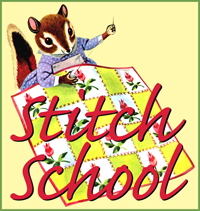Someone must have linked to my "Stitch School: Blanket Stitch" post recently as I’ve been getting lots of comments, and a couple of questions.
Chloe asks: “I want to use this stitch to finish a fleece blanket. What is the best way to start and finish with the floss when you have no where to hide loose ends? Because of the size of the blanket I can’t use one long piece to stitch all the way around. I’ve tried tying the new piece to the last one but found it difficult to get it just right. I don't want to end up with pieces of floss sticking out every time I have to start with the new piece. Any tricks to that?”
Unfortunately when you’re edging a large item—like a fleece blanket—you’ll have to do some starting and stopping and you don’t have a hem or folded edge to hide your knots inside. The only thing you can do is to be as neat as possible with your knots. Always keep them at the bottom but slightly under the edge towards the back side. Make your knot right at the place that holds down the thread from the previous stitch, and begin again at that same place. Trim any extra threads away from the knot to keep it as neat as possible.
As artists and crafters we’re often more critical of our own work than others are. Most people aren't going to look closely enough to even see the knots.
Carrie asks: “How do you know how many threads of floss to use? Or is that just a matter of preference? Also, it looks like it is all sewn with the floss as a single strand tied at one end as opposed to doubled and tied together. Is that correct?”
It really is just a matter of preference. It’s pretty standard to break the floss in half so you have two lengths of three strands each, but, if you’re doing something very delicate, like a lightweight linen tea towel, you may want to use just two strands. I sometimes use just one if I'm outlining in black—like for an eye and eyelashes. For blanket stitch, especially on a heavier weight fabric, you may want to use all six strands.
I usually knot the length at one end. I find doubled-over thread (sewing thread or embroidery) harder to work with because it twists, but that’s just my preference. You have to do what’s right for you, even if that’s different from the way everyone else does it.
I'm still super busy with design projects and restocking my website with goodies (including new embroidery patterns) for the upcoming holiday season. That seems like a long ways away but it's never too early to get started. I've purchased a magazine ad (more details to come later) and, fingers crossed, hope it will bring lots of new customers and sales. I do plan to start Stitch School up again soon, but you can always practice the basic stitches in the meantime.
9.13.2007
Subscribe to:
Post Comments (Atom)
















No comments:
Post a Comment